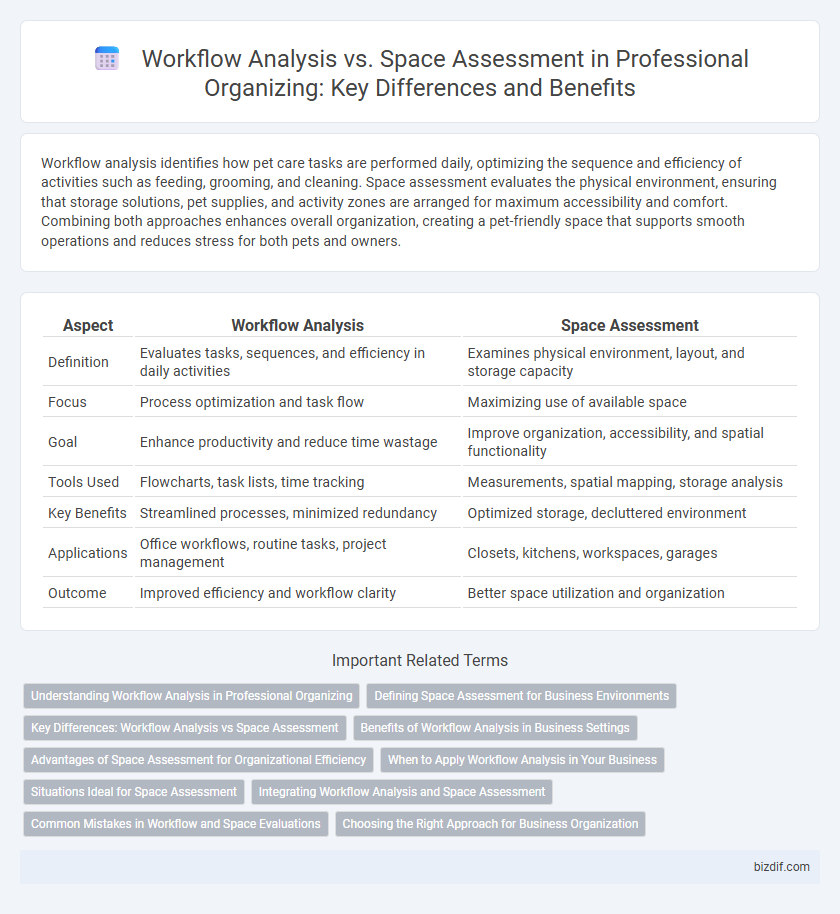Workflow analysis identifies how pet care tasks are performed daily, optimizing the sequence and efficiency of activities such as feeding, grooming, and cleaning. Space assessment evaluates the physical environment, ensuring that storage solutions, pet supplies, and activity zones are arranged for maximum accessibility and comfort. Combining both approaches enhances overall organization, creating a pet-friendly space that supports smooth operations and reduces stress for both pets and owners.
Table of Comparison
| Aspect | Workflow Analysis | Space Assessment |
|---|---|---|
| Definition | Evaluates tasks, sequences, and efficiency in daily activities | Examines physical environment, layout, and storage capacity |
| Focus | Process optimization and task flow | Maximizing use of available space |
| Goal | Enhance productivity and reduce time wastage | Improve organization, accessibility, and spatial functionality |
| Tools Used | Flowcharts, task lists, time tracking | Measurements, spatial mapping, storage analysis |
| Key Benefits | Streamlined processes, minimized redundancy | Optimized storage, decluttered environment |
| Applications | Office workflows, routine tasks, project management | Closets, kitchens, workspaces, garages |
| Outcome | Improved efficiency and workflow clarity | Better space utilization and organization |
Understanding Workflow Analysis in Professional Organizing
Workflow analysis in professional organizing involves examining the sequence of tasks and how individuals interact with their environment to enhance efficiency and reduce clutter. Unlike space assessment, which focuses on the physical layout and available storage, workflow analysis prioritizes optimizing processes to streamline daily activities. Understanding workflow analysis enables organizers to tailor solutions that improve productivity by aligning organizational systems with natural work patterns.
Defining Space Assessment for Business Environments
Space assessment for business environments involves evaluating the physical layout, storage solutions, and spatial efficiency to enhance workplace productivity and organization. This process identifies clutter hotspots, underutilized areas, and ergonomic concerns to optimize flow and resource allocation. Unlike workflow analysis, which focuses on task sequences and process efficiency, space assessment prioritizes spatial dynamics to create functional, accessible workspaces.
Key Differences: Workflow Analysis vs Space Assessment
Workflow analysis evaluates task sequences, identifying bottlenecks and inefficiencies in processes to optimize time management and productivity. Space assessment examines physical environments, focusing on spatial layout, storage solutions, and accessibility to enhance functionality and organization. The key difference lies in workflow analysis targeting process optimization, while space assessment concentrates on physical space utilization.
Benefits of Workflow Analysis in Business Settings
Workflow analysis in business settings identifies inefficiencies and streamlines operations by examining task sequences and employee interactions, resulting in increased productivity and cost savings. Unlike space assessment, which focuses primarily on the physical environment, workflow analysis targets process optimization to enhance organizational performance. Implementing workflow analysis supports data-driven decision-making and facilitates continuous improvement in professional organizing strategies.
Advantages of Space Assessment for Organizational Efficiency
Space assessment identifies physical constraints and opportunities within a workspace, allowing for tailored organization solutions that enhance accessibility and reduce clutter. This approach improves workflow by optimizing the use of existing space, leading to increased productivity and reduced time spent searching for items. In contrast to workflow analysis, space assessment directly addresses the tangible environment, creating an efficient layout that supports organizational goals and daily operations.
When to Apply Workflow Analysis in Your Business
Workflow analysis is essential when seeking to improve operational efficiency by identifying bottlenecks and redundant tasks within your business processes. It is most effective during periods of rapid growth, introducing new technologies, or restructuring teams to streamline task execution and enhance productivity. Unlike space assessment, which focuses on physical organization, workflow analysis targets the optimization of task sequences and communication flows for better overall business performance.
Situations Ideal for Space Assessment
Space assessment is ideal for situations where physical layout and storage optimization directly impact efficiency, such as cluttered rooms, inefficient furniture arrangement, or limited storage options. This approach identifies spatial constraints and maximizes usability by evaluating dimensions, traffic flow, and accessibility. Unlike workflow analysis, space assessment focuses primarily on the physical environment rather than task sequences or process efficiency.
Integrating Workflow Analysis and Space Assessment
Integrating workflow analysis and space assessment enhances professional organizing by aligning physical layouts with user behaviors and task sequences, improving efficiency and reducing clutter. Workflow analysis identifies bottlenecks and movement patterns, while space assessment evaluates storage capacity and accessibility, creating a holistic view of organizational needs. This combined approach ensures functional, customized environments that support productivity and sustainable organization.
Common Mistakes in Workflow and Space Evaluations
Common mistakes in workflow analysis include overlooking task dependencies and ignoring employee input, which can lead to inefficient processes. In space assessments, professionals often fail to consider actual usage patterns, resulting in cluttered or underutilized areas. Accurate evaluations require integrating workflow dynamics with spatial realities to optimize organizational effectiveness.
Choosing the Right Approach for Business Organization
Workflow analysis evaluates the efficiency of processes, identifying bottlenecks to optimize task management and improve productivity. Space assessment examines physical layout and storage solutions to enhance accessibility and reduce clutter in the work environment. Selecting between workflow analysis and space assessment depends on whether your priority is streamlining operations or maximizing the functional use of your workspace.
workflow analysis vs space assessment Infographic

 bizdif.com
bizdif.com